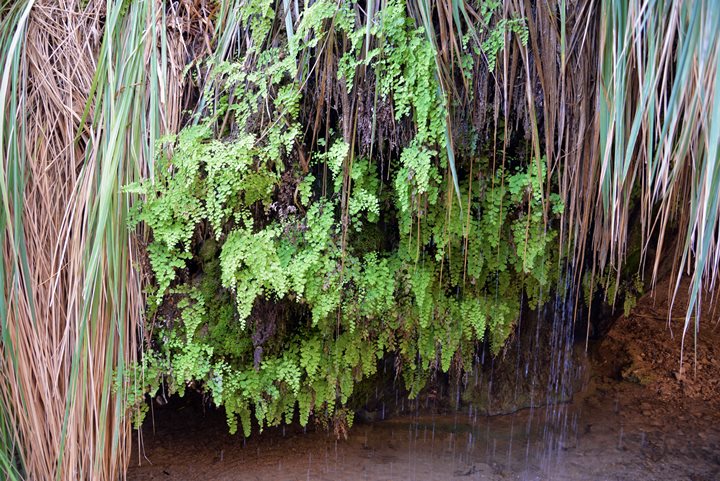Nahal-David stream is a nature reserve in the Judean desert that flows to the Dead sea near Ein Gedi. 1 Samuel 24 1: “Behold, David is in the wilderness of Engedi”.
Home > Sites > Dead Sea > Ein Gedi > Nahal David stream
Contents:
Overview
Location
Photos
* David Waterfall
* Upper Nahal david
* Shulamite’s spring
* David Trail
* Dodim cave
* Cave of the Pool
Biblical
Etymology
Links
Overview:
Nahal David:
The Nahal David stream flows year round on the northern side of Ein-Gedi. It is known for its springs, caves and history.
Ein Gedi and Nahal David were inhabited starting from the Chalcolithic period (5,000 years ago), and a temple from that period was excavated there. Along the stream are several findings from the Chalcolithic period to the Early Roman period.
This area is where David hid from the pursuing King Saul (1 Samuel 23 29: “And David went up from thence, and dwelt in strong holds at Engedi“). The stream is named after King David.
Today Nahal David is a nature reserve, open to the public, and a wonderful hike.
Ein Gedi Natrure Reserve:
Gedi Nature Reserve is one of Israel’s most beautiful natural areas, located on the western shore of the Dead Sea. It is a lush oasis in the middle of the Judean Desert, offering a stark contrast to the surrounding arid landscape. The reserve is famous for its rich biodiversity, ancient history, and stunning natural beauty.
Key Highlights:
- Wadi David and Wadi Arugot: These are the two main hiking trails in the reserve, featuring waterfalls, natural pools, and diverse plant life. Wadi David is known for being more accessible, while Wadi Arugot offers a more challenging hike.
- Flora and Fauna: Ein Gedi is home to a variety of plant species, including acacia trees, date palms, and the unique Sodom apple. Wildlife in the reserve includes ibexes (wild goats), rock hyraxes, and a variety of bird species.
- Historical Sites: The reserve also has significant archaeological sites, including the ruins of an ancient synagogue with a beautiful mosaic floor and the remains of a Chalcolithic temple.
- Ein Gedi Kibbutz: Nearby, the Ein Gedi Kibbutz offers accommodation and a botanical garden, providing a perfect base for exploring the area.
- Ein Gedi Spring: The spring itself is a vital source of fresh water in the area, historically used for agriculture and sustenance by ancient communities.
Activities:
- Hiking: The reserve offers several trails, ranging from easy walks to more strenuous hikes.
- Swimming: There are natural pools along the trails where visitors can cool off.
- Wildlife Watching: Spotting the native ibexes and other animals is a popular activity.
- Photography: The dramatic landscape, with its combination of desert and lush greenery, offers excellent opportunities for photography.
Tips for Visitors:
- Best Time to Visit: The cooler months from October to April are ideal for visiting, as the summer can be extremely hot.
- Bring Water: It’s essential to carry plenty of water, especially if you plan to hike the longer trails.
- Respect Nature: As a protected area, it’s important to follow guidelines to preserve the natural environment.
Ein Gedi is a must-visit for nature lovers, history enthusiasts, and anyone looking to experience the unique beauty of the Dead Sea region.
Location:
Nahal David flows into the Dead sea, north of Ein Gedi. An aerial map of the Nahal David nature reserve area is shown below, indicating the major points on interest.
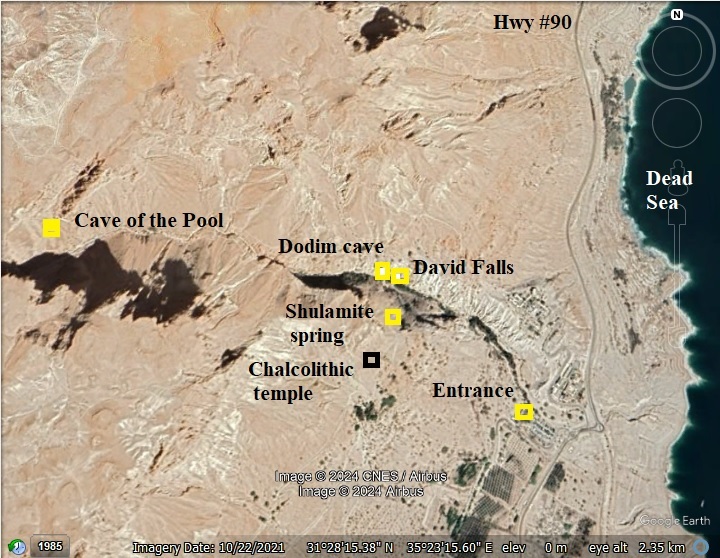
Photos:
a) David waterfall
Photos in section a) – by Tuvia & Shachar Liran.
The most visited section in the valley of Nahal David stream is the David waterfall, located in the lower section of the valley.
David waterfall is seen below, with Tuvia under the falling stream. The best way to cool down a hot day in the desert…
A closer view of the waterfall is seen below.
b) Walk to Upper Nahal David
The upper section above the falls can be reached from the south bank of Nahal David stream valley.
We ascended to the Chalcolithic temple and Ein Gedi spring, then took the Nahal David trail nature trail towards the valley.
The trail leads to Shulammite spring and Dodim cave.
From the trail are great views of the Dead Sea, Ein Gedi Inn and the parking area at the bottom of the nature reserve.
c) Shulamite’s spring
Shulamite’s Spring, also known as “Ein HaShulamit,” is a picturesque and historically significant spring located within the Ein Gedi Nature Reserve in Israel. It is one of the four springs in the Ein Gedi Oasis, located on the southern cliff of Nahal David, 160m north east of the Chalcolithic temple.
The name “Shulamite” is often associated with the beautiful woman described in the Song of Songs, a book in the Hebrew Bible (Song of Solomon 7:1): “Return, return, O Shulamite; Return, return, that we may look upon thee”
Although there is no direct evidence linking the spring to this figure, the name evokes the romantic and poetic imagery of the area.
Here is a view of the spring:
An aqueduct leads from the spring down the mountain. During the Roman period the aqueduct was cleverly channeled along the cliffs, taking advantage of the natural topography to maintain a steady gradient. This ensured a continuous flow of water down to the hewn reservoirs at the base of the mountain.
In modern times the high quality water is partially used by the Ein Gedi Mineral water company, while some of the waters flow into the valley. A concrete structure and pool was built in the 1980s to divert the waters to the bottling plant in Kibbutz Ein Gedi.
At the end of the aqueduct, the water was conveyed into reservoirs that were carved out of the rock. These reservoirs stored the water, making it available for use during dry periods. It was used for irrigating the fields during the Roman and Byzantine periods. The surveyors identified six storage pools east of the spring along the slope of the wadi.
The excavators traced the aqueduct to one of the pools, examining 4 sections. Its total length is 160m and the overall slope is 2.5%. One excavated section (“A”) near the spring, 12m in length, was buried under 0.5m of pebbles that accumulated over the years. The sides of the aqueduct was built of fieldstones lined with plaster. The U shaped trench’s outer width is 80cm and inner width is 20cm. The bottom was built of wadi pebbles, at a depth of 20cm. The top was covered by ceramic slabs.
Based on ceramics found along the aqueduct, the surveyors of the aqueduct dated its construction and use to the Early Roman period (Hasmonean period, 1st century BC) up to the Byzantine period (4th-6th century AD). During this long period the aqueduct was maintained and repaired, and at the last phase of use was upgraded with ceramic slabs resembling roof tiles.
d) Nahal David Trail
Continuing along the nature trail, and down to to the valley of Nahal David, leads to the Dodim cave. This trail is used to both descend and then return back using the same route, as the cave is a dead end.
The Nahal David trail is considered easy to moderate, making it accessible to most visitors, including families with children. It’s a relatively short hike, typically taking about 1-2 hours to complete, depending on how long you spend enjoying the scenery and pools. The trail is about 2 kilometers (1.2 miles) long. There is a gentle ascent along the trail, but it’s not overly strenuous.
In one of the sections, the trail descends through a staircase under a natural tunnel.
The trail passes the bottom of the valley. Inside the stream are small pools where you can dip into them and cool off the heat.
The stream fills up small pockets of pools along the course of its descent.
In another section of the trail, the walk is along the cliffs on the north side of the stream
Just above the cave is a more difficult section, where you use handrails to climb down (and later use them to climb back on).
e) Dodim cave
Dodim cave is at the end of the trail. The name “Dodim” interprets as “Lovers” in the Hebrew Song of Solomon, and the cave is sometimes referred to as the “Cave of Lovers,” likely due to its secluded and romantic setting.
In the Hebrew Bible the word for “beloved” is “Dodi” (דּוֹדִי). A sample: (Song of Solomon 2:8-10): “The voice of my beloved! behold, he cometh leaping upon the mountains, skipping upon the hills. “קוֹל דּוֹדִי הִנֵּה-זֶה בָּא מְדַלֵּג עַל-הֶהָרִים מְקַפֵּץ עַל-הַגְּבָעוֹת”. There are many such lines with Dodi, hence in plural: Dodim.
Key Features of the Dodim Cave:
- Secluded Oasis: Dodim Cave is nestled in a secluded spot along the Nahal David trail, surrounded by lush vegetation and the sound of flowing water. The cave provides a cool, shaded retreat from the heat of the desert.
- Natural Formation: The cave is a natural formation, carved out over millennia by the forces of water and erosion. Inside, the walls are smooth, and the atmosphere is tranquil, with the gentle echo of water dripping from the rocks.
- Waterfall and Pool: One of the highlights of Dodim Cave is the small waterfall that cascades near the entrance, feeding a natural pool. This pool is a favorite spot for hikers to cool off and relax during their trek through Nahal David.
- Scenic Surroundings: The area around Dodim Cave is characterized by dramatic cliffs, lush greenery, and the flowing stream of Nahal David. The contrast between the arid desert outside and the verdant, water-rich environment within the cave area makes it a special place to visit.
- Romantic Ambiance: The cave’s secluded location and serene environment have led to its association with romantic imagery. It’s a popular spot for couples seeking a quiet, intimate moment in nature.
A view of the cave:
Another view of the cave:
On the side of the cave are ferns. They are also named on the subject of love of the Song of Solomon – Shulamite ferns. In Song of Solomon the subject of love is described has having a beautiful hair, like the ferns (4:1):
“Behold, thou art fair, my love; behold, thou art fair; thou hast doves’ eyes within thy locks: thy hair is as a flock of goats, that appear from mount Gilead”.
Dodim Cave in Nahal David is a hidden gem within the Ein Gedi Nature Reserve, offering a peaceful and picturesque retreat in the midst of the desert. Its combination of natural beauty, serene atmosphere, and historical significance makes it a must-visit spot for those exploring the area.
(f) Cave of the Pool
The Cave of the Pool is located on the upper section of Nahal David, on the eastern cliffs. Excavations in the area have uncovered evidence of human activity dating back thousands of years, providing valuable insights into the ancient history of the Ein Gedi region.
Archaeological Significance of the Cave of the Pool:
- Ancient Inhabitants: The cave and its surroundings have been found to contain remnants of human habitation from various periods, including the Chalcolithic (approximately 4500–3500 BCE) and the early Bronze Age. These findings suggest that the area around Nahal David was an important site for early human settlement, likely due to the availability of fresh water from the springs and pools.
- Artifacts and Remains: Excavations in and around the Cave of the Pool have uncovered a range of artifacts, including pottery shards, stone tools, and other implements used by the ancient inhabitants. These items provide a glimpse into the daily lives of the people who lived in the area thousands of years ago.
- Burial Sites: In the broader Ein Gedi region, including areas near the Cave of the Pool, archaeologists have discovered ancient burial sites. These graves often contain well-preserved skeletal remains, along with burial goods such as jewelry, pottery, and weapons. The presence of these burial sites indicates that the area held significant cultural and spiritual importance.
- Religious and Ritual Significance: Some scholars believe that the caves in the Ein Gedi area, including the Cave of the Pool, may have been used for religious or ritual purposes. The discovery of certain artifacts and the strategic location of the caves suggest that they could have served as places of worship or spiritual retreats for the ancient inhabitants.
- Connection to the Ein Gedi Settlement: The Cave of the Pool is part of the larger archaeological landscape of Ein Gedi, which includes the ruins of an ancient Jewish settlement, a synagogue with a well-preserved mosaic floor, and agricultural terraces. The cave’s proximity to these sites suggests that it may have been integrated into the daily life of the community, possibly as a source of water or a place of refuge.
Findings and Interpretations:
- Preservation: The relatively dry climate of the Judean Desert has helped preserve many of the artifacts found in the area, allowing archaeologists to piece together a more detailed picture of life in ancient Ein Gedi.
- Continuity of Use: The findings indicate that the area around the Cave of the Pool was continuously used by different cultures over thousands of years, reflecting the enduring importance of this natural oasis in an otherwise harsh desert environment.
- Ongoing Research: Archaeological research in the Ein Gedi region, including the Cave of the Pool, continues to this day. Each new excavation season has the potential to uncover further details about the ancient cultures that once thrived in this area.
The excavations of the Cave of the Pool in Nahal David have deepened our understanding of the historical and cultural significance of the Ein Gedi region. The findings from these excavations highlight the cave’s role not only as a natural wonder but also as a site of human activity and spiritual significance over millennia.
Biblical References:
(a) 1 Samuel 23 29, 24:1
Ein-Gedi was the place where David hid while being pursued by King Saul:
“And David went up from thence, and dwelt in strong holds at Engedi“.
“And it came to pass, when Saul was returned from following the Philistines, that it was told him, saying, Behold, David is in the wilderness of Engedi“.
(b) Song of Solomon 1:14
The vineyards of Ein Gedi (EnGedi) were celebrated in King Solomon’s times:
“My beloved is unto me as a cluster of camphire in the vineyards of Engedi“
Etymology (behind the name):
- Nahal – Hebrew for brook or river (Wadi in Arabic).
- Tzemach-Ad – the initials of the 5 main brooks between Masada (in the south) and Ein Gedi (in the north) combine a Hebrew word which means “green plant” which makes it is easy to remember. The brooks are: Tseelim, Mishmar, Hever, Arugut and David.
- Ein Gedi – Hebrew: Ein-spring, Gedi – young goat. Prof Mazar suggested that Gedi is based on “Gedud” which means “many”, and translates Ein Gedi to “many springs” – based on the four springs of the site which give it life in this dry area.
- Wadi Sideir – the Arabic name of Nahal David (as in PEF maps), named after the Jujube (Christ’s thorn, Sheizaf) trees that grow in its valley
- Ain Jidy (A’in Jidi) – the Arabic name of Ein Gedi (as in PEF maps); preserved the ancient name
Links:
- Ein Gedi Nature Reserve – web site
- Nahal David, Cave of the pool excavations – HaEsi (2005) (2009) (2013) – Findings from Neolithic period through Second temple period
- ‘En Gedi, ‘En Shulamit – Final report; Oren Shmueli, HAESI 123 2011
BibleWalks.com = Touring the Bible Land
Nahal Arugot<<<—previous site—<<< All Sites >>>—next Dead Sea site—>>> Ein-Gedi
This page was last updated on Aug 24, 2024 (add upper section of Nahal David, total overhaul)
Sponsored links:
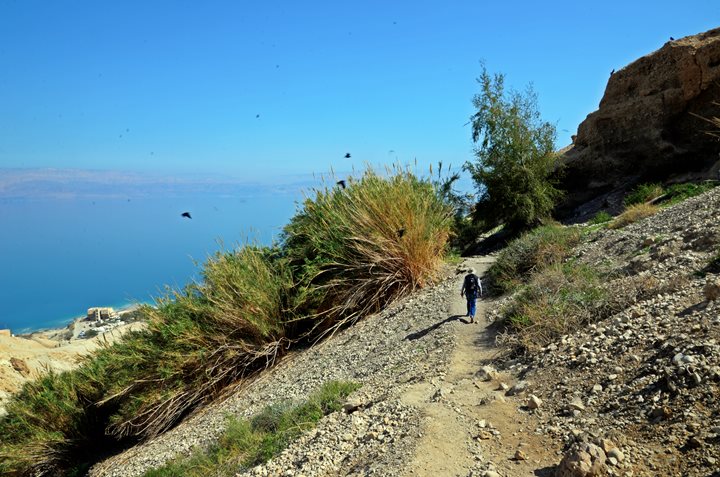
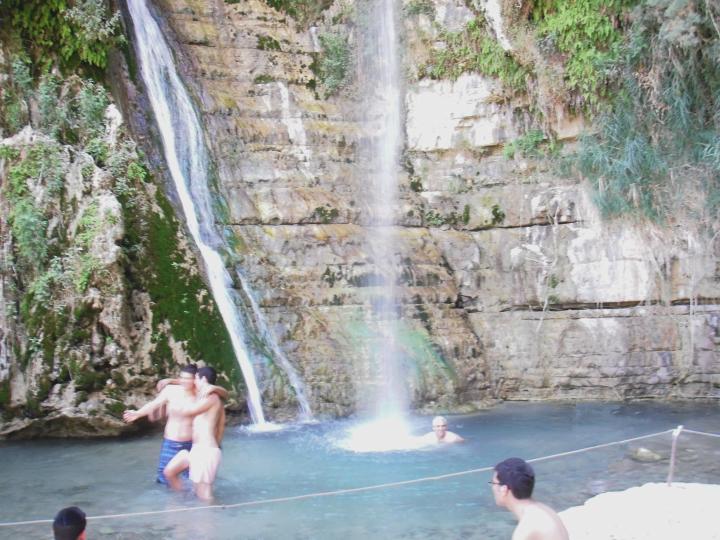


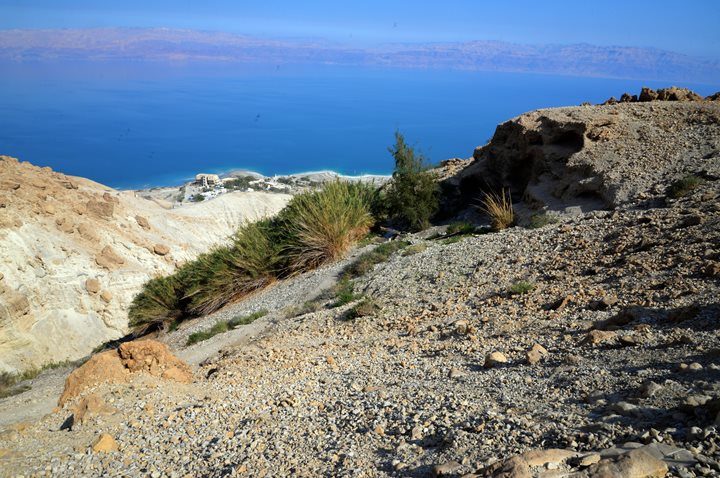

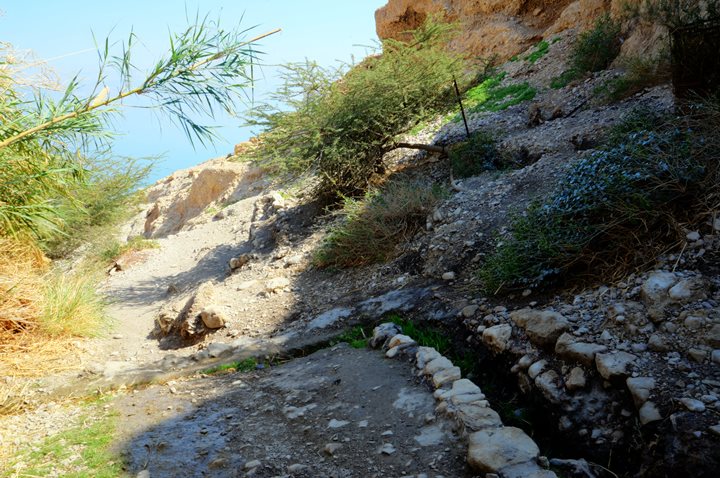
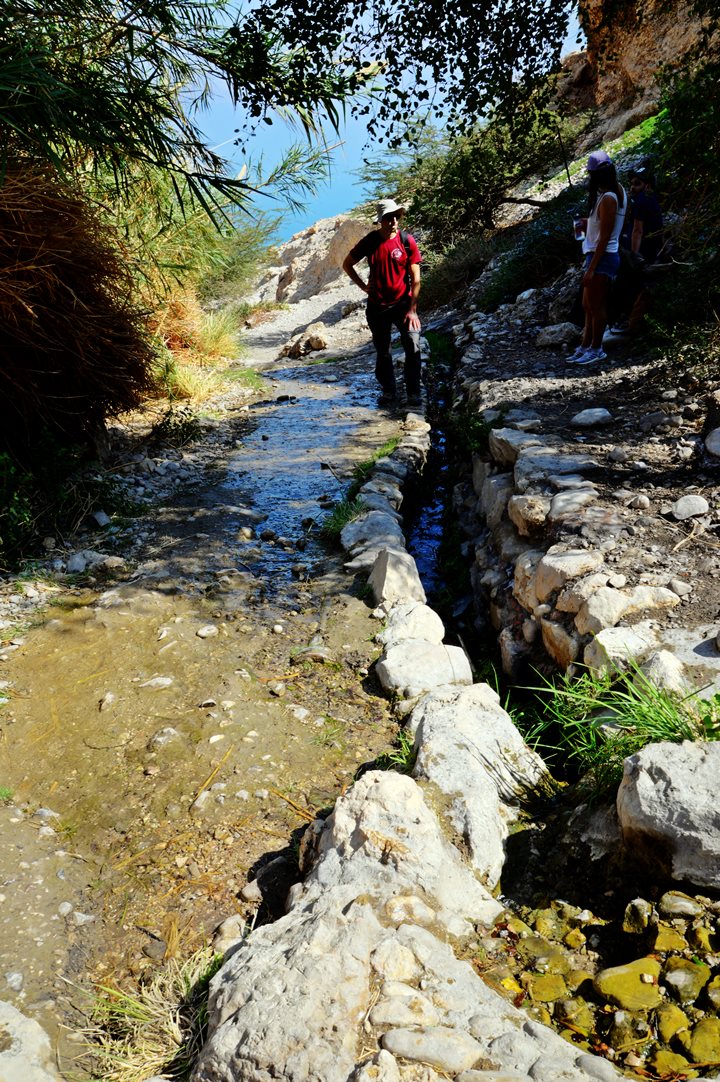

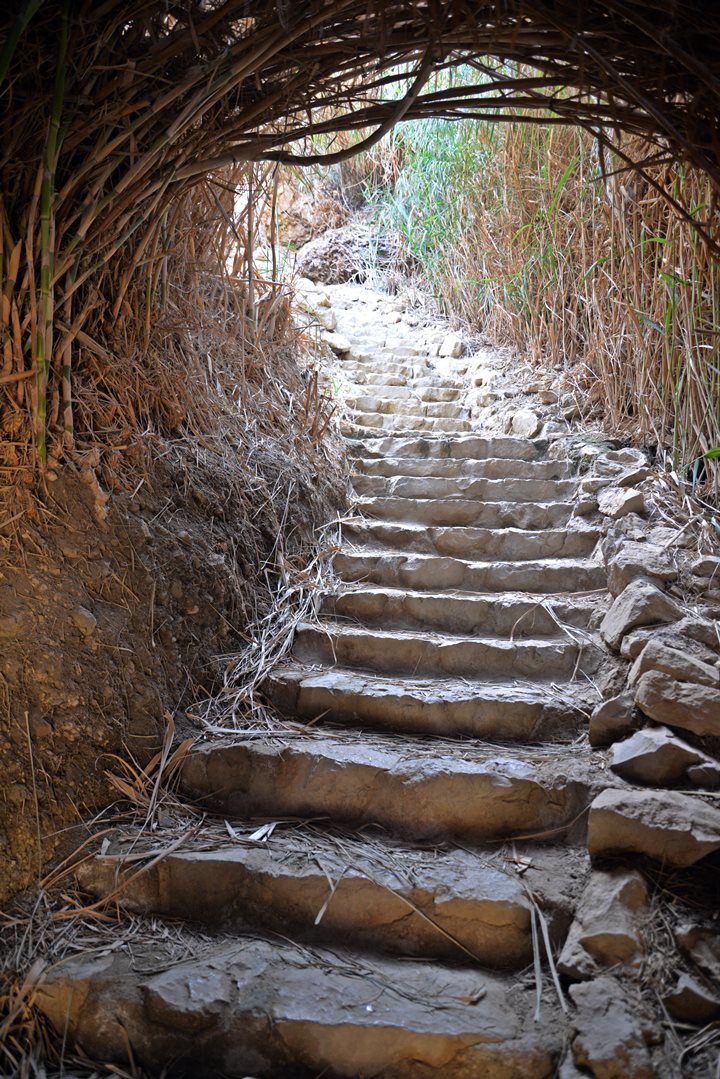

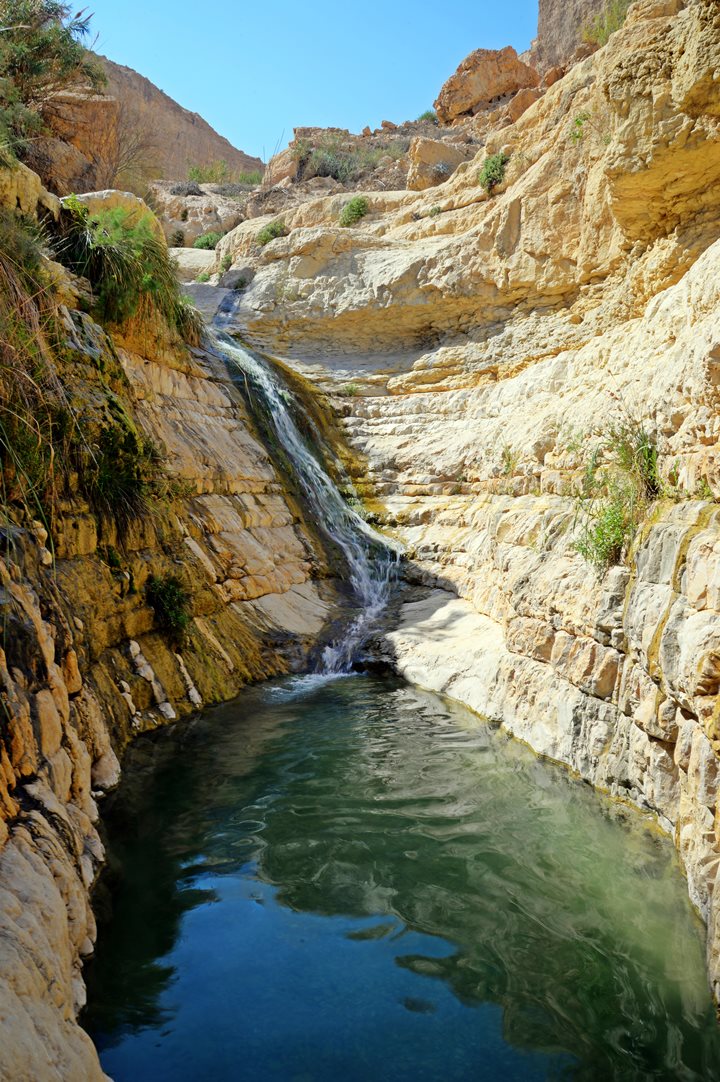
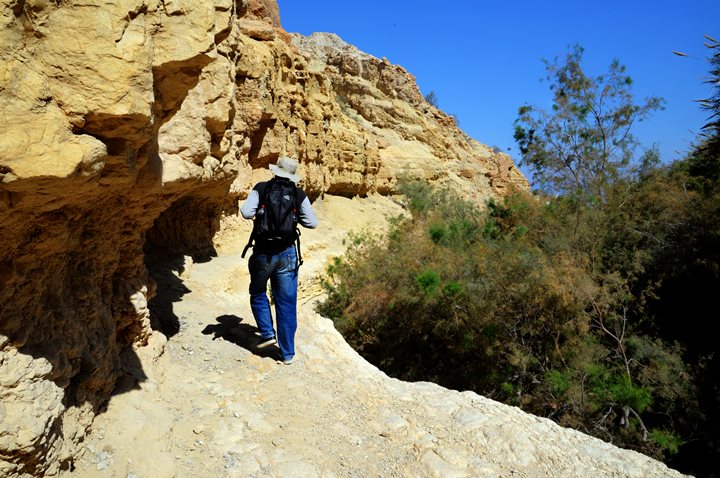

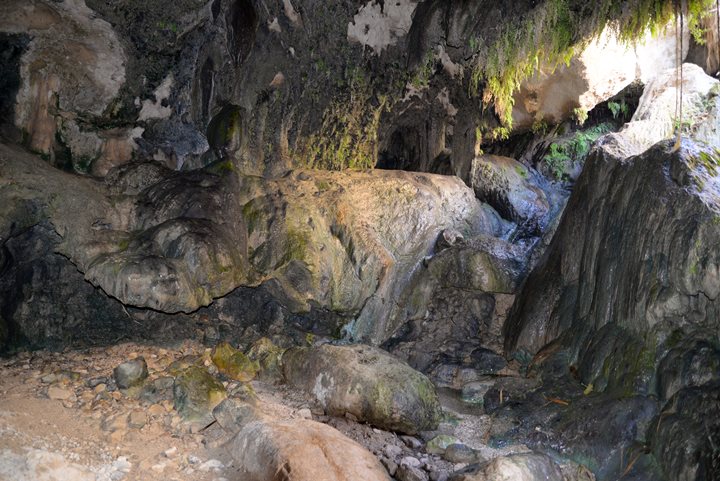 \
\
